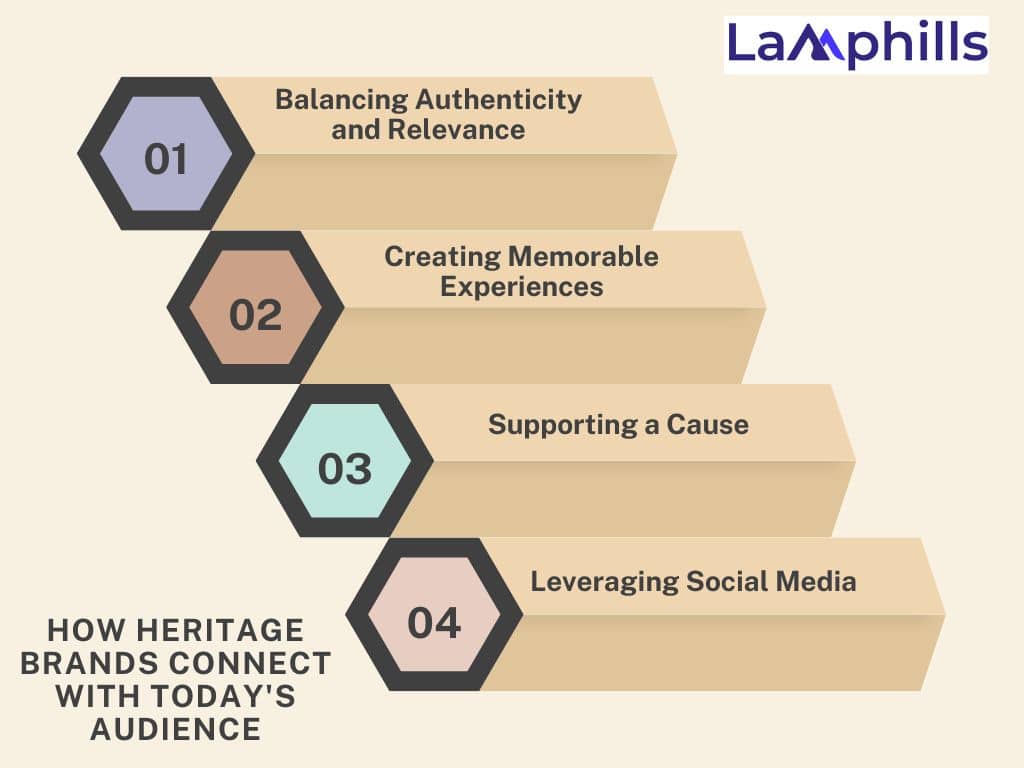If you want to learn about Heritage Brands, you’re in the right article.
Have you ever wondered why some brands have been around for hundreds of years, but you’ve only just heard about them? That’s because while some brands focus on their history, others don’t highlight their past much. For example, Hugo Boss might avoid talking about its ties to Nazi Germany, and L’Oreal may focus more on being a forward-thinking luxury brand.
In today’s fast-changing world of marketing and branding, companies work hard to create a unique identity that connects with their customers. Two common terms you might hear are “heritage brands” and “brands with heritage.”
Branding expert David Aaker says, “Building a heritage brand isn’t just about looking at the past. It’s about telling a story that links the past, present, and future. This story should inspire customers and help the brand keep growing.”
This article explains Heritage Brands, including what makes these brands special and why they continue to be a big part of our lives today. Keep reading.
Key Points
- Heritage brands have unique stories that connect their past to the present, like Chanel, which started in a small Paris shop and has grown into a global fashion icon.
- These brands have been around for years, and people trust them because of their long-lasting quality. Think of brands like Levi’s and Rolex.
- Brands like Louis Vuitton stay true to their roots while adding fresh ideas, which helps them remain popular with today’s customers.
- Heritage brands use events and experiences, like Coca-Cola’s airport pop-ups, to make their history come alive and engage people in new ways.
- They are trusted because they stand the test of time.
What Is a Heritage Brand?
I remember the day I truly understood what a heritage brand is. I was in my grandfather’s attic, surrounded by old suitcases, worn-out watches, and faded photographs. But what caught my attention was a pair of perfectly preserved shoes with the name Clarks on them.
These shoes belonged to my grandfather, yet they still looked stylish and well-made after all these years. It made me wonder how some brands stay relevant and loved for so long.
A heritage brand represents a company’s long history and tradition, which are key parts of its identity and marketing. These brands have been around for many years, sometimes even centuries, and use their history to build trust and show their authenticity and quality. Heritage brands have a lasting charm, and people often see them as symbols of excellence passed down over time.
When you think of brands like *Burberry*, *Coca-Cola*, or *Rolex*, you don’t just think of products. You think of the legacy they’ve built, the honesty they show, and the strong connection they’ve created with their customers.
Brands with Heritage
On the other hand, Brands with heritage are companies that have been around for a long time, but they don’t always highlight or use their history in their marketing or branding for different reasons. While these brands have a deep history, they don’t necessarily make it the focus of their branding strategy. Instead, they work on evolving and staying relevant in today’s fast-changing market.
The Story Behind Heritage Brands
Heritage brands are more than just names. They represent quality, tradition, and trust. They remind us of memories and stories while still being popular in today’s fast-moving world.
One thing that makes heritage brands stand out is the story behind them. Many of these brands started as small family businesses or were founded by people with strong vision. For example, *Levi’s* started during the California Gold Rush, providing durable clothing for miners. Today, the same spirit of toughness and quality lives on in their modern clothing lines, connecting the past with the present.
I’ve also read about *Chanel* and how Gabrielle “Coco” Chanel started her journey in a small shop in Paris. She went on to completely change women’s fashion. It’s not just the products these brands offer that draw people in; it’s also the passion and vision that still drive them today.
Heritage brands know how to balance their original values with the needs of modern consumers, making them both classic and current at the same time.
To understand how heritage brands can stay strong and relevant, let’s take a closer look at their strengths, weaknesses, opportunities, and threats. This SWOT analysis will help you see how heritage brands can use their long history to succeed while adapting to modern challenges.
How Heritage Brands Connect with Today’s Audience
In today’s world, staying popular is not easy. Trends change fast, and people always want something new. So, how do heritage brands, which are rooted in history, stay relevant?
From what I’ve seen, the secret is in how they adapt without losing their identity. Take *Louis Vuitton*, for instance. It started in 1854 as a luggage brand, and today, it’s a global fashion powerhouse. Yet, their famous monogram and focus on quality haven’t changed much.

It’s interesting how heritage brands mix tradition with modern touches. *Burberry* was one of the first fashion brands to use technology, like live-streaming their fashion shows and engaging with people on social media. However, their classic trench coat is still a favorite, showing that timeless designs can fit right into the modern world.
However, heritage brands can’t just rely on their past success. The best ones keep evolving to stay relevant. They face many challenges, especially because of their long history, but they succeed by using smart marketing to stay true to their brand while staying fresh through the following means:
#1. Balancing Authenticity and Relevance
Heritage brands also face a unique challenge: staying true to their roots while appealing to modern consumers. With so many options available today, younger buyers may not automatically connect with these older brands.
A key issue is staying authentic. These brands must keep delivering the same craftsmanship and quality they’re known for. If they try too hard to change, they risk losing what made them special in the first place. At the same time, they can’t ignore new technologies and trends. If they do, they may seem outdated.
So, how can heritage brands stay relevant while holding onto their core values? Here are some strategies that have worked for well-known brands.
#2. Creating Memorable Experiences
One of the best ways for heritage brands to connect with people is by creating memorable experiences. These experiences let consumers engage with the brand’s history and feel part of its journey.
Some of these experiences are online, like virtual tours, but the most powerful ones are hands-on, such as pop-up events or interactive displays. These types of events help people build an emotional connection to the brand, which can lead to customer loyalty.
For example, Coca-Cola created a cozy space at Chicago’s O’Hare Airport where travelers could relax and enjoy a limited-edition flavor. Adidas did something similar by revamping a vintage bus and touring New York City to promote one of their 1980s basketball shoes. These experiences highlight the brand’s story in a fun and engaging way.
#3. Supporting a Cause
Heritage brands can also show their modern values by supporting causes that align with their core mission. For example, *The Economist* worked to raise awareness about food waste. They used a food truck and gave free samples to engage people and promote their message. This not only got attention but also boosted subscriptions by showing they care about current issues.
When heritage brands get involved in causes, it shows they’re still in touch with the world today, making them more appealing to younger generations.
#4. Leveraging Social Media
Social media is another powerful tool for heritage brands. By sharing their story, values, and products through photos, videos, and text, they can reach new audiences. It’s also a great way to celebrate events or milestones, showing the brand is still active and relevant.
Le Creuset, a cookware brand, focuses on high-quality content using visually-driven platforms like Instagram and TikTok. This allows them to show off their colorful products while engaging with their audience in a way that feels fresh and modern. Brands like Estée Lauder also use TikTok to explain their products to younger consumers, especially Gen Z, which has helped them build new connections.
#5. Updating Design
Keeping up with design trends is important for all brands, but heritage brands must do it carefully. Changing too much could alienate loyal customers who love the classic look. Instead, they can update their design while keeping key elements of their original style.
Levi’s does this well by using vintage-inspired designs that appeal to new customers and long-time fans.
#6. Collaborating with Influencers
Partnering with influencers, celebrities, or artists is a quick way for heritage brands to seem fresh and relevant. This approach allows them to tap into the influencer’s audience and reach new customers.
Le Creuset, for example, collaborates with influencers in different industries, like food, fashion, and home decor, to spread the word about their brand. It’s important to choose influencers who genuinely align with the brand’s values to ensure the partnership feels authentic.
By using these strategies, heritage brands can stay relevant and attract new customers without losing the core elements that made them successful in the first place.
Why Do People Trust Heritage Brands?
I think our trust in heritage brands goes beyond the products themselves. It’s about the emotional bond we build with these brands over time. For example, drinking Coca-Cola at a family picnic or wearing a pair of *Ray-Ban* sunglasses on a sunny day reminds me not only of my own experiences but also of the generations before me.
Heritage brands stand for reliability. When you buy a *Timberland* boot or a *Gucci* handbag, you’re not just following a trend. You’re investing in something that has been proven to last for decades, if not longer. These brands have earned their reputation by delivering quality, trust, and craftsmanship year after year.
Sustainability and Heritage Brands
Another reason why heritage brands continue to matter is their focus on sustainability. With more people today caring about the environment, these brands keep their traditions alive while adopting eco-friendly practices.
I’ve been impressed with brands like *Patagonia*, which, even though it’s newer, ties its outdoor heritage with its commitment to protecting the planet. The same goes for *Stella McCartney*, who blends her family’s fashion legacy with a strong focus on sustainability. These examples show that heritage brands can successfully combine tradition with a vision for the future.
5 Iconic Heritage Brands That Have Stood the Test of Time
Some brands have not only been around for a long time but have also stayed important and loved by people across generations. Here are five heritage brands that have maintained their place in our lives by staying true to their values while adapting to modern times.
#1. Coca-Cola
Coca-Cola is one of the most famous drinks in the world. It started in 1886, and even though it’s over a hundred years old, it remains as popular as ever. Its strong brand identity and ability to adapt to change have kept Coca-Cola relevant. The company constantly introduces new flavors, campaigns, and advertisements, but the classic red logo and original recipe still remind people of the product they’ve loved for decades.
From its humble beginnings as a local soda to becoming a global icon, Coca-Cola has always found ways to stay relevant while holding onto its roots. The timeline below highlights some of the key moments in Coca-Cola’s journey, showing how the brand has evolved and grown over the years.
#2. Levi’s
Levi’s was founded in 1853 during the California Gold Rush. Levi Strauss created durable jeans for miners, and today, the brand is still known for its tough, high-quality denim. Levi’s has managed to stay relevant by staying in touch with fashion trends. Their jeans remain a classic, but they also offer new styles and fits for younger generations. Even though the brand has evolved, their jeans still carry the same legacy of durability and style.
#3. Rolex
Rolex, the luxury watch brand, has been a symbol of success and quality since 1905. People around the world trust Rolex because of its precise engineering and timeless designs. While the world of fashion and technology has changed, Rolex watches have remained classic. The brand’s secret is focusing on its craftsmanship and exclusivity while also updating their designs to suit modern tastes.
#4. Burberry
Burberry, founded in 1856, is known for its iconic trench coats and signature plaid pattern. Over the years, the brand has kept its traditional British roots while embracing new technologies, like using social media and live-streaming fashion shows. Burberry manages to stay relevant by mixing old-world elegance with modern trends, ensuring that their coats and fashion items remain both stylish and timeless.
#5. Louis Vuitton
Founded in 1854, Louis Vuitton started as a luxury luggage brand and has since become one of the biggest names in fashion. The brand has expanded to clothing, handbags, and accessories while maintaining its reputation for high-quality craftsmanship. The key to Louis Vuitton’s success is its ability to keep up with fashion trends while still offering classic, luxury products like its iconic monogrammed bags. Their designs appeal to both older generations and the younger, fashion-forward crowd.
These brands have lasted through the years because they know how to balance tradition with modern needs. They stay true to their original values, like quality and authenticity, while continuing to innovate and evolve with the times. This is what makes them icons in the world of heritage brands.
Final Words
Finally, Heritage brands hold a special place in the market. They are known for their unique identity, long history, and values passed down through many years. These brands often have a strong reputation for quality, reliability, and customer satisfaction. Many have stayed successful for generations, with rich stories that help them connect with people.
I’ve always found heritage brands to be more trustworthy than newer ones. You know what you’re getting, whether it’s the refreshing taste of Coke or the classic Burberry coat design. There’s a sense of comfort in that predictability.
Answers to FAQs.
What are heritage brands?
Heritage brands are companies with a long history and a strong reputation. Examples include Chanel, Louis Vuitton, Hermès, Rolls-Royce, Cadbury, and Levi’s. These brands aren’t just about their past—they build a story that ties together their history, current success, and future growth.
What is a heritage clothing brand?
A heritage clothing brand is one that has been around for a long time and has stood the test of time. However, it’s not just about being old. These brands usually have a distinct, rugged style that sets them apart from others.
What’s an example of a heritage brand?
Hermes is the world’s oldest fashion brand and has a rich history. Founded by Thierry Hermes in 1837, the company has stayed in the family for five generations. This deep sense of tradition and family ownership helps the brand build emotional connections with customers and earn their trust.
What Brands are Using Cultural Branding
- Nike’s “Just Do It” campaign speaks to people across different cultures. It taps into the shared feeling of overcoming challenges and achieving success.
- Coca-Cola’s “Open Happiness” slogan promotes a universal idea of joy and togetherness, making it easy for people everywhere to relate to.
- Apple’s “Think Different” campaign encourages creativity and individuality, inspiring people from all walks of life to challenge the norm.
- McDonald’s “I’m Lovin’ It” slogan focuses on simple pleasures and enjoying the moment, which resonates with people worldwide.
What is a corporate heritage brand?
A corporate heritage brand is a company that builds its identity and values around its long history. This idea came from our in-depth research on how monarchies act as brands.
What are some legacy brands?
Legacy brands include companies like Porsche, Lacoste, and Nike. These brands have earned the trust and loyalty of older customers over many years by consistently building a strong reputation.
Similar Articles
Streetwear Brands: The 9 Hottest Nigerian Streetwear Brands You Should Know
Cognac Brands: The Leading Cognac Brands in Nigeria and Their Prices
THE TOP 50 BAG BRANDS IN THE WORLD: THE BEST IN LUXURY AND STYLE






